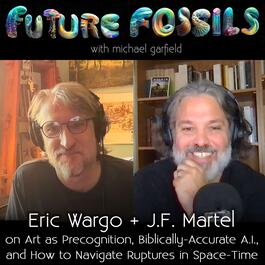
⏳🎨🔮 231 - Eric Wargo & J.F. Martel on Art as Precognition, Biblically-Accurate A.I., and How to Navigate Ruptures in Space-Time
Subscribe, Rate, & Review on YouTube • Spotify • Apple Podcasts ✨ Support & Participate • Become a patron on Substack (my preference) or Patreon (15% off annual memberships until 12/21 with the code 15OFF12)• Make a tax-deductible donation to Humans On The Loop• Original paintings available as thank-you gifts for large donors• Hire me as an hourly consultant or advisor on retainer• Buy the books we discuss from Bookshop.org• Join the Future Fossils Facebook group• Join the Holistic Technology & Wise Innovation and Future Fossils Discord servers• Buy the show’s music on Bandcamp — intro “Olympus Mons” from the Martian Arts EP and outro “Sonnet A” from the Double-Edged Sword EP, coda “You Don’t Have To Move → 8:33” from The Age of Reunion ✨ About This Episode In this penultimate episode of Future Fossils before we transform into Humans On The Loop, I bring two of my favorite guests and comrades in the so-called “Weirdosphere” back for their first-ever conversation together — and it’s a real banger! Probably the most inspired and provocative conversation I’ve ever had on the nature of time and human creativity. Joining me for this trialogue are Eric Wargo, author of From Nowhere: Artists, Writers, and the Precognitive Imagination (previously on FF episodes 117 and 171), and J.F. Martel, author of Reclaiming Art in The Age of Artifice and co-host (with Phil Ford) of Weird Studies podcast (previously on FF episodes 18, 71, 126, and 214). Our discussion centers on the concept of precognition — the ability to perceive future events — as the mechanism of all human creative activity. Both Eric and J.F. argue that art, like shamanistic practices, acts as a means of accessing and expressing precognitive experiences, often manifesting as seemingly coincidental events or uncanny correspondences between art and reality. We talk about the role of trauma and dissociation in stimulating creative breakthroughs — why there seems to be a direct biological and psychological link between suffering, displacement, and the discovery of radical new insights and modes of being. Can we create without destroying, or are rupture and connection one thing? We also examine how emerging media through the ages have shaped our experience of time. Starting with the earliest Paleolithic artifacts and the role of cave art in facilitating or encoding ecstatic experience, we trace the evolution of art through to how the development “the cut” in modern cinema led to new ideas of causality. Each new medium provides novel ways of thinking about leaps across space and time, and their study offers new points of entry into a unifying philosophy of rupture and discontinuity. Lastly, we explore some of my own most potent and disquieting precognitive experiences in light of Eric’s argument that the UFO phenomenon may actually be the braided precognitive experiences of future human beings and symbiotic artificial intelligences — a thesis that sheds new light on everything from the lives and work of Philip K. Dick, Jacques Vallée, Carl Jung, Andrei Tarkovsky, to The Book of Ezekiel. Where we’re going, we won’t need roads… Speaking of art, UFOs, psychedelic experience, and time machines, here’s the standalone music video for the song we discuss in this episode that was inspired by my UFO (or were they time machine) experiences in 2007. I threw it back in as a coda to the episode but in case you want to view it in its original resolution and in the context of the entire album, here you go. The “8:33” section starts around 3:58: ✨ Chapters Chapter 1: Introduction (0:00:00) Chapter 2: Precognitive Imagination in the Arts (0:08:57) Chapter 3: The Personal is Precognitive (0:13:34) Chapter 4: The Cut and the Leap (0:22:15) Chapter 5: The Brain as a Fast-Forwarder (0:30:38) Chapter 6: Campfires, TVs, and Flickering Consciousness (0:38:57) Chapter 7: The Trauma of Truth (0:48:04) Chapter 8: Prophecy and The Trash Stratum (0:54:33) Chapter 9: UFOs as Time Machines, The Disappointment of Destiny (1:14:39) Chapter 10: Closing and News on Upcoming Releases (1:20:28) ✨ Other Mentions An inexhaustive list of people, places, and key works mentioned in this episode. * Morgan Robertson: Author of a novel that is believed to have predicted the sinking of the Titanic. * Hunter S. Thompson: Author and journalist. * William Shakespeare: Playwright who wrote Macbeth. * Comte de Lautréamont: A French poet who talked about "the cut" in his work. * Jean Epstein: Author of the book on the philosophy of cinema, The Intelligence of a Machine. * Carl Jung: Psychoanalyst who developed the concept of synchronicity. * Sergei Eisenstein: Filmmaker, and film theorist. * Gilles Deleuze: Philosopher who argued that “difference is more fundamental than identity.” * Cy Twombly: Artist whose work is discussed by Eric Wargo. * Andrei Tarkovsky: Filmmaker who wrote a diary entry quoted in From Nowhere. * Philip K. Dick: Science fiction author whose experiences with precognition and synchronicity are discussed in From Nowhere. * Jacques Vallée: Scientist and ufologist, author of a book about the UFO phenomena called Passport to Magonia. * Diana Pasulka: Academic who studies the UFO phenomenon. * Johnjoe McFadden: Scientist who works on quantum biology. * Henri Bergson: Philosopher known for his work on time and consciousness, is quoted as saying “the universe is a machine for the making of gods.” * Octavia E. Butler: Science fiction author. * Harlan Ellison: Science fiction author. * James Cameron: Filmmaker who directed The Terminator. * Max Simon Ehrlich: Screenwriter who wrote the Star Trek episode The Apple. * Megan Phipps: Guest on the Future Fossils podcast (episode 214). * Michelangelo: Guest on the Future Fossils podcast who discussed Paisley Ontology and precognition with Michael Garfield. * Björk: Musician, whose song "Modern Things" is mentioned. * Greg Bishop: UFO historian. * Terence McKenna: Ethnobotanist and writer who coined the term "immanentize the eschaton.". * Phil Ford: Co-host of the Weird Studies podcast. * Richard Wagner: Composer who was arrested in 1837. * Zozobra: a hundred-year-old effigy burn in Santa Fe, NM. * Esalen Institute: the center of the Human Potential movement, in Big Sur, CA. * The Fort-Da Game: A game observed by Sigmund Freud in which a child throws a toy away and then retrieves it, demonstrating an understanding of object permanence. * The Third Man Factor: A phenomenon experienced by explorers and mountain climbers in extreme survival situations, involving the feeling of a presence accompanying them. This is a public episode. If you’d like to discuss this with other subscribers or get access to bonus episodes, visit michaelgarfield.substack.com/subscribe
From "Humans On The Loop"


Comments
Add comment Feedback